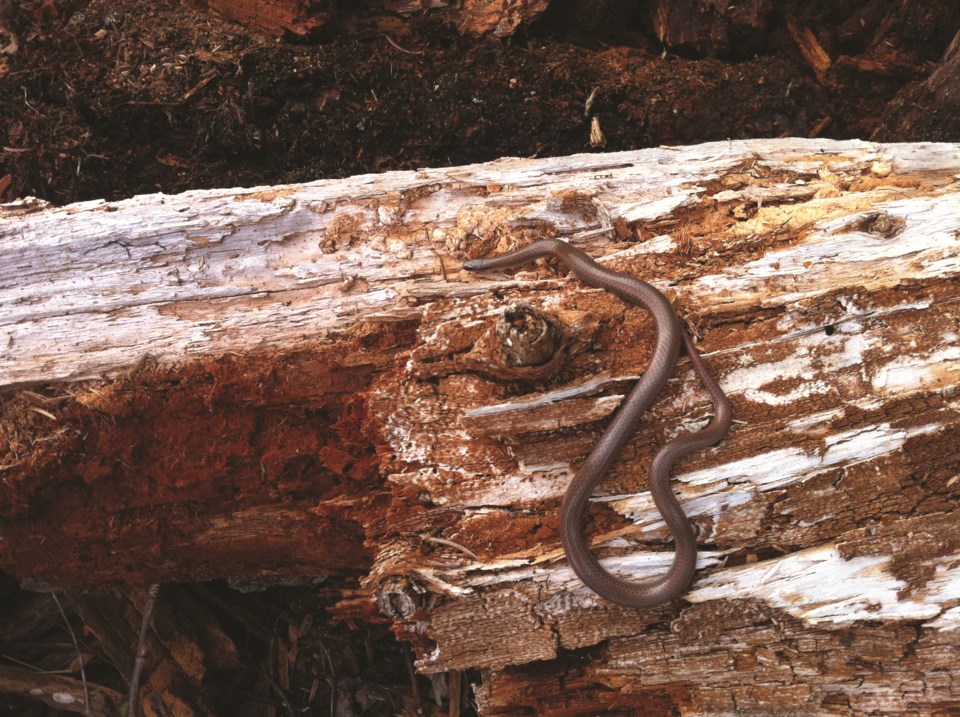The Stewardship Pemberton Society (SPS) is one step closer to its goal of protecting the habitat of a rare endangered snake in the Pemberton Valley, thanks to funding from the Squamish-Lillooet Regional District.
On May 11, the SPS received a grant of $2,000 from the regional district to help with a snake habitat protection and trail relocation project that is being done in partnership with the Pemberton Valley Trails Association (PVTA).
The popular trail set to be rerouted is known as Mission Impossible 3 in the Mackenzie Basin trail area. The trail connects the Mackenzie Forest Service Road (FSR) to the bike parking lot near the Sunstone neighbourhood, where the snake was first discovered in the valley.
“We’re just looking to restrict access to this important piece of habitat while still making sure that the trail use in the area is maintained, given how popular mountain biking is in Pemberton,” said SPS co-founder Veronica Woodruff.
At almost the length of a pencil, the tiny sharptail snake is extremely rare and only found in small pockets across the West Coast of North America. The discovery of the snake near Pemberton in 2011 was surprising, as it was the northernmost discovery of the snake and the only population discovered on the mainland of British Columbia.
“It’s found in Washington [state], about 300 kilometres away, and it’s found on Vancouver Island and some of the Gulf Islands. So it’s very small, about the size of a pencil, and it doesn’t go very far in its whole life. So it’s kind of a funny sighting where we don’t really know where that snake is coming from because 300 kilometres is quite a range expansion for that snake,” said Woodruff.
“Since 2011, we’ve been doing different assessments to understand the distribution of sharptail snakes in Pemberton, and then working with the experts who know this population really well from Vancouver Island. And the thing with sharptail snakes is the only places that we’ve really found it are in areas that are either being developed or are slated for development.”
To further understand the habitat of the sharptail snake, Stewardship Pemberton brought in a group of students from the British Columbia Institute of Technology who were working on their Masters of Ecological Science to research and recommend options to protect the snake.
The students created a 36-page report that looked at various available options, including building boardwalks in the area, but in the end, it was agreed that decommissioning the area’s trails was the most efficient and cost-effective measure that could be taken.
“In coordination with the Pemberton Valley Trails Association [PVTA] and Veronica [Woodruff] at Stewardship Pemberton, we worked out a proposed trail reroute to allow us to keep the trail in place but also save the snake habitat,” said PVTA president Emily Slaco.
“Once the new route has been flagged, and everyone is happy with the new line, then the trail will be closed, and the work on the new trail will begin. The area where there is sensitive snake habitat will be deactivated and closed off using natural materials in an effort to minimally disturb this sensitive zone. We are currently planning to begin some work the week of May 23 and have the new route open by May 30.”
The habitat in question is important because it is a hibernaculum, essentially a “snake hotel,” where snakes congregate together to stay warm over the winter months.
“They need very specific habitat structures in order to have a good winter snooze, and that structure is actually quite limited. There’s a lot of it out there, but a lot of the hibernacula have a whole bunch of species using the same habitat,” said Woodruff. “So where the structure exists, you kind of get the snake hotels, where you’ve got sort of a rocky slope, and there’s going to be little compartments in there. For the alligator lizard, the garter snake, the rubber boa, and the sharptail snake.”
Find more info on the endangered sharptail snake at stewardshippemberton.com/sharp-tailed-snake-study.




